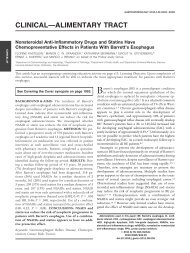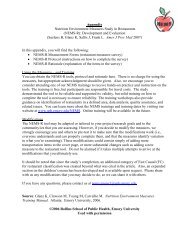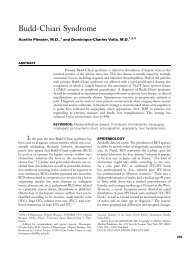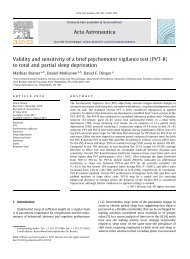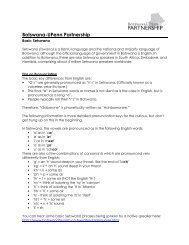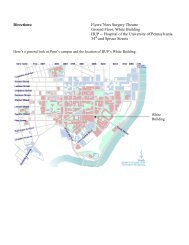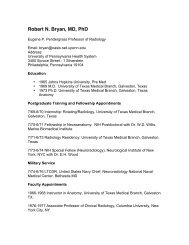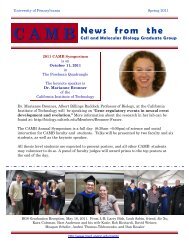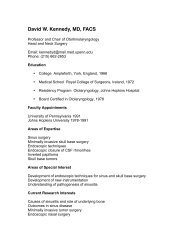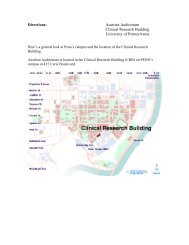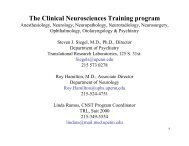PPP_Summer 2010_EDITED FINAL 072010:PPP.qxd - University of ...
PPP_Summer 2010_EDITED FINAL 072010:PPP.qxd - University of ...
PPP_Summer 2010_EDITED FINAL 072010:PPP.qxd - University of ...
Create successful ePaper yourself
Turn your PDF publications into a flip-book with our unique Google optimized e-Paper software.
PAGE 4<br />
Continued from page 3<br />
view and questionnaires.<br />
Based upon results <strong>of</strong> the diagnostic evaluation,<br />
COTTAGe clinicians make treatment recommendations.<br />
These may include a referral to a member <strong>of</strong><br />
the program staff or to another mental health care<br />
pr<strong>of</strong>essional. COTTAGe <strong>of</strong>fers Cognitive Behavioral<br />
Therapy (CBT), a form <strong>of</strong> talk therapy, in individual<br />
or family-based treatment formats. Most psychosocial<br />
treatment programs meet weekly for approximately<br />
12 to 16 weeks. Periodic follow-up sessions<br />
are also conducted, as needed, to solidify therapeutic<br />
gains. COTTAGe’s psychosocial treatments are<br />
based on cognitive-behavioral principles and involve<br />
education, as well as teaching patients and parents<br />
specific skills to cope with challenging situations.<br />
Of the specific disorders that COTTAGe treats, OCD<br />
is the one most prevalent in the general population,<br />
affecting between 1 and 4 percent <strong>of</strong> children. COT-<br />
TAGe <strong>of</strong>fers an intensive CBT treatment program for<br />
OCD for those from out <strong>of</strong> town, for the more severe<br />
cases, or for people who have taken time <strong>of</strong>f from<br />
work or school to focus on treatment. The intensive<br />
program lasts 3 1/2 weeks (week days only), including<br />
17 double-length sessions, each about 90 to 120<br />
minutes, and utilizes exposure and ritual prevention<br />
therapy. With proper treatment, OCD is highly treatable.<br />
Dr. Franklin is careful not to promise that OCD or<br />
any <strong>of</strong> the other disorders treated at COTTAGe can<br />
be completely cured. COTTAGe clinicians realistically<br />
aim for an outcome somewhere between cure and<br />
management by reducing the presence and intensity<br />
<strong>of</strong> the adverse behaviors and symptoms which<br />
plague patients.<br />
"’Cure’ suggests complete eradication <strong>of</strong> neurobiological<br />
vulnerabilities,” says Dr. Franklin, “which I<br />
don't think is possible at present, whereas ‘management’<br />
suggests continuing as best as possible,<br />
despite compromised functioning.” But there is<br />
much that can be done, and COTTAGe clinicians<br />
<strong>of</strong>fer the very latest in what modern medicine and<br />
science have to <strong>of</strong>fer. “There is great deal <strong>of</strong> evidence<br />
now that CBT for OCD and related disorders can<br />
yield outcomes that are comparable to if not in some<br />
cases superior to medication alone,” Dr. Franklin<br />
continues, “and that combined treatments <strong>of</strong>fer benefits<br />
that may well be above and beyond what can be<br />
achieved with medication alone.”<br />
Dr. Franklin recognizes that additional investigation<br />
PENN PSYCHIATRY PERSPECTIVE � SUMMER <strong>2010</strong><br />
is needed to understand better the etiology and<br />
course <strong>of</strong> anxiety and body-focused repetitive disorders<br />
in youth and to develop improved therapies.<br />
“Understanding the mechanisms by which these<br />
treatments work is essential in the next stage <strong>of</strong><br />
research development,” he says, “as is the dissemination<br />
<strong>of</strong> these empirically supported interventions<br />
to the many people and families who do not currently<br />
have access to them.”<br />
COTTAGe clinician-scientists have taken up this scientific<br />
challenge. Currently, they are conducting two<br />
While these disorders are found in<br />
adults, Dr. Franklin has chosen to treat<br />
young people. He says that his background<br />
in treating patients <strong>of</strong> all ages<br />
and the medical literature taught him<br />
“that many adults with these disorders<br />
reported the onset <strong>of</strong> symptoms in childhood<br />
or during adolescence.”<br />
research studies in early childhood OCD and Trichotillomania,<br />
<strong>of</strong>fering opportunities for children<br />
and adolescents to participate at no cost for eligible<br />
families. Both studies are funded by the National<br />
Institute <strong>of</strong> Mental Health (NIMH).<br />
The "Family-Based Treatment <strong>of</strong> Childhood OCD"<br />
study is a multi-center trial, now in its recruitment<br />
phase. It is designed to test a family-based CBT<br />
treatment program for young children with OCD.<br />
Participants receive family-based CBT targeting children's<br />
OCD symptoms or family-based relaxation<br />
training aimed at general anxiety reduction and<br />
stress management. Children aged 5 through 8 who<br />
have symptoms <strong>of</strong> OCD may be eligible to participate.<br />
The treatment program lasts 14 weeks, followed<br />
by check-ins at 3, 6, and 12 months after<br />
treatment has finished. As part <strong>of</strong> the therapy, participants<br />
have weekly family meetings with a doctor<br />
who specializes in childhood anxiety disorders.<br />
Because <strong>of</strong> the young age range <strong>of</strong> program participants,<br />
“teaching parents how to assist their child in<br />
treatment is essential to making progress,” says Dr.<br />
Franklin.<br />
The second ongoing clinical trial – “Behavioral Ther-<br />
Continued on page 5<br />
www.med.upenn.edu/psych




